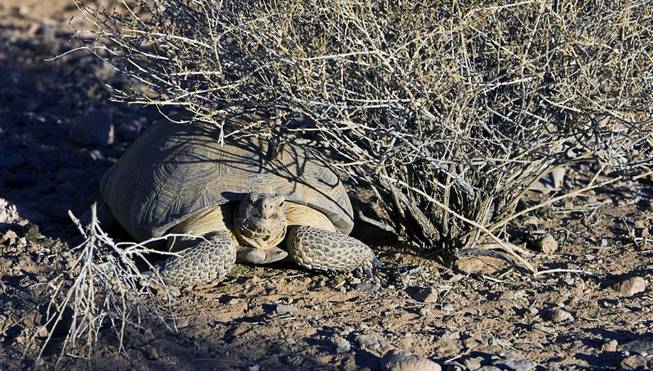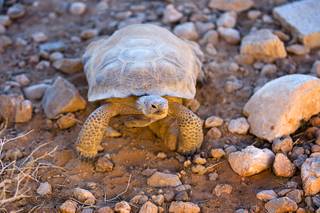
A Mojave Desert tortoise is shown in a quarantine area at the Desert Tortoise Conservation Center in Las Vegas on Friday, Sept. 2, 2011. The tortoise, some kept by people as pets, will be returned to the wild when they are healthy enough to leave.
Tuesday, Dec. 3, 2013 | 7:20 p.m.
After spending $95 million since 2001 protecting Southern Nevada’s desert tortoise population, Clark County commissioners are looking for a way to reduce the costs of caring for the threatened species.
The issue: Commissioners heard a report today on the county’s Multiple Species Habitat Conservation Plan, which details measures to protect 78 threatened and endangered species in the area.
The vote: No action was taken. Commissioners asked staff to reach out to neighboring states and Nevada’s congressional delegation to seek potential resolutions to lower the costs of protecting threatened species.
What it means: Nearly 25 years after the desert tortoise was first listed as a threatened species, several commissioners are fed up with the high costs of protecting the animals.
The desert tortoise was first listed as an endangered species in 1989, but was later revised to a threatened species.
In 2001, the county implemented its habitat conservation plan, which allows development to continue on 145,000 acres that are home to the tortoises in return for expensive conservation measures.
Since the plan was enacted, the county has spent $95 million protecting 78 threatened and endangered species, including $15 million on desert tortoises.
Those funds are generated by a $550 per-acre fee collected when land is developed. The money goes toward a variety of efforts, including habitat restoration, protective fencing and species monitoring.
Commissioner Steve Sisolak first raised the issue at a November board meeting during a routine approval for a $125,000 contract to monitor the tortoise population.
“I know we can’t use the money for anything else and that the money is collected for this,” he said. “But it’s still money that taxpayers, the developers are paying. There are 100,000 good uses for a good portion of this money.”
With as many as 295,000 desert tortoises in 26,000-square-mile area stretching across California, Arizona, Nevada and Utah, plus thousands more tortoises kept as pets, Sisolak wondered whether the hundreds of millions being spent by the county and the federal government could be put to better use elsewhere.
The county’s conservation plan stretches until 2031, meaning costs will continue to add up without the guarantee that the tortoise will eventually be delisted.
The county could petition to have the species delisted sooner, but doing so would require it to hire teams of biologists to survey the tortoise population and conduct further research, a costly proposition.
Without a clear way to reduce the costs associated with protecting the tortoise and other endangered species, commissioners asked staff to begin reaching out to neighboring states also paying to protect the tortoise.
Their hope is that by partnering with other states and getting the support of Nevada’s congressional delegation, changes can be made to reduce the costs of protecting the desert tortoise.
“Sometimes things start and they just don’t end because no one says anything,” Commissioner Susan Brager said of the conservation efforts. “I think it’s time for us to say something.”



Join the Discussion:
Check this out for a full explanation of our conversion to the LiveFyre commenting system and instructions on how to sign up for an account.
Full comments policy